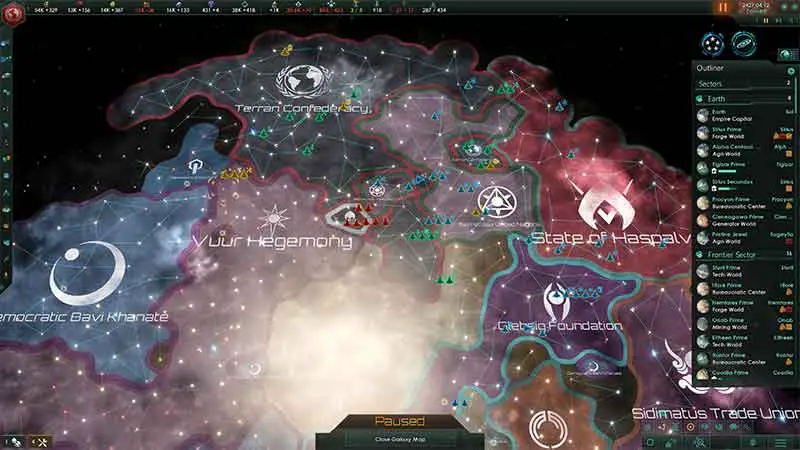
Starting with the United Nations of Earth is one of the best empires to start out with as a beginner. For one thing it’s pretty straightforward and secondly, it’s an empire most players can easily identify with, making some of the concepts easier to understand. You can easily change the appearance, origin, empire name, traits, and a myriad of other stuff at the empire screen but for learning the basics of the game accepting the defaults works perfectly.
Rapid exploration and expansion, researching buildings that increase resources, building mining and research stations and rapidly increasing your population are the keys to success in the early game.
If you intend to Become the Crisis then do not use the United Nations of Earth since it has the Xenophile ethic which won’t allow you to select the “Become the Crisis” Ascension perk. The Commonwealth of Man would be a better choice if you want to become the crisis.
After selecting an empire to play you’ll be taken to the game details screen. There are a lot of overwhelming options for a beginner but in order to set up an easy game for learning the game basics these are the most important options. Learning how to play Stellaris can be overwhelming too, I wrote an entire page about learning how to play Stellaris.
Read More: Having trouble getting Stellaris to run?
Set the Galaxy size to tiny (200 stars). One advantage to this size is avoiding the micromanagement of a huge empire while still having a minimal amount to work while learning. This galaxy size will give you a real good idea of what managing an empire in Stellaris is all about and will allow you to bump into other empires more quickly. When learning, keeping things manageable can go a long way!
The game should default to an Elliptical galaxy. Leave it set to that option, a spiral galaxy can box you in if you have nasty neighbors who are more powerful than you, and a ring galaxy may present more tactical choices than you would want to make when learning the game.
This is a tiny galaxy so set AI empires to 2, that way you have a few empires to jostle with, but you don’t want too many in a small galaxy or things will get real ugly real fast. This is the number of AI controlled empires you’ll be competing against.
Set Advanced AI Starts to 0. This determines how many enemy empires get a head start over your empire, whether it be resources, technology or population. Their only advantage is a better starting position. No reason to fight an uphill battle when you’re first learning the game.
Set Fallen Empires to 1. These are ancient empires who once flourished but now no longer expand or build new ships, but what they have is very powerful. Might as well learn to deal with these guys now..
Turn on Marauder Empires. Unruly neighbors who do a lot of fighting amongst themselves. They like to raid you and their neighbors and are known to fight for hire. Might as well learn about everything the game has to offer.
Leave or set the Tech/Tradition cost to 1x. Setting it to a higher number makes it take longer to complete research. Since this a short game you don’t want to delay this any more than what the normal speed is.
Set Habitable Worlds to 1.5x. This gives a decent bump in the number of habitable worlds you’re likely to find. The more you find the more quickly you can colonize and learn the basics of running an empire. You’ll also get more opportunities to try out the game’s new automation features for planets.
Leave the Primitive Empires setting at 1x.
Crisis Strength should be set at .5x or lower. This is essentially the end of the game. This setting lessens the strength of the enemy fleets that arrive during the end game crisis. Fun to play but frustrating if you’re leaning and they simply come into your galaxy and wipe the floor up with you. For a new player this will at least give you a chance to beat it.
Accept the defaults for the Mid, End, and Victory year (2300, 2400, 2500). Once the Victory year is hit the game calculates who the winner is, but you can keep playing if you want to.
For a beginning game set the Difficulty to Civilian. This gives you massive bonuses for your economy, research and naval capacity plus it makes it much easier to establish favorable first contacts. It gives a new player a significant edge over the AI.
Set Scaling Difficulty to off. Turning it off stops the AI from becoming too powerful as the game progresses.

Set Difficulty Adjusted AI Modifiers off. During the end game AI economies will not become significantly stronger.
Set the AI Aggressiveness to low. You need to fight a few wars to gain combat knowledge about the game but not too many. This determines how often the AI will declare war on enemies, including you.
Empire Placement can be set to Clusters.
Set Advanced Neighbors to Off. This prevents an advanced empire from spawning close to you.
Leave Hyperlane Density, Abandoned Gateways and Wormhole Pairs set to 1.
Guaranteed Habitable Worlds. Set it to 2. This determines the number of planets that are the same as your homeworld being created close to your system.
Caravaneers. Leave it on. These are space-based traders, fun to interact with.
If it’s available set L-Gates to on.
Set Xeno-Compatibility on.
Set Logistic Growth Ceiling to 1. This controls how fast pops will increase. Higher settings can impact late-game performance unless you have a high-end gaming PC.
Set Growth Required Scaling to 1. This also slows down pop growth.
Turn Ironman Mode off. The game won’t be eligible for achievements, but you need the option to save games and go back and correct mistakes, or to try different approaches, when learning.
Click Play and the game loads, starts and VIR (or whoever the Advisor is set to) should introduce itself. If that doesn’t happen you will need to go into the game settings and turn on the full tutorial. Go to the game menu (hamburger icon in lower right corner). Click it to bring up the menu options and then select the Gameplay tab at the top of the dialog box. The tutorial can be set to either Full or Tips. Set it to Full, then click Apply and return to the game.
Stellaris Beginner Strategy
Send Science Ships out to explore the galaxy. It’s best to build a second one to speed up exploration in the early game.
It’s important to get resources flowing into your empire as quickly as possible. Build mining stations first, it’s safe to ignore research stations for now until the costs of research really start increasing.
Colonize as much space as possible but try to focus on the best planets with high habitability first. This helps an economy grow and stops your empire from being hemmed in. If you can’t colonize then grab some promising systems by building an Outpost if you have enough Influence. The main drawback to colonizing rapidly is that research costs increase as you get more colonies, but early expansion is still a must.
Build up the planet economies so you’ll have a strong empire. You’ll need a strong empire economy to support research, exploration, and war. Always watch your planets for unemployed pops. Having too many can result in high crime, lost production, and instability in the planet’s government. A good rule of thumb it to focus on what the planet is best suited for. If it has a lot of generator districts, build power districts first and add a power grid when it becomes available to boost production even further. By focusing on one area of production the planet may get a bonus in that area of expertise as well.
When you start bumping into neighbors its time to worry about the Navy and build it up sufficiently enough to counter any potential threat. Having a strong military is one of the best ways to prevent war being declared on you by the AI since it takes your military strength into account. Don’t be an easy target!
At the beginning of the game you should get the opportunity to research buildings that increase resource output, like Global Energy Management, which provides an Energy Grid and the Capacity Overload Edict. The Energy Grid provides a 15% planetary increase.
Hydroponic Farming and Geothermal Fracking will probably be available for research too. Hydroponic Farming unlocks Hydroponic Farms and Hydroponic starbase bays which provide an increase in food production. Geothermal Fracking will give a 20% boost to Miner Mineral Production. Make each of these a priority when available.
One last thing to focus on is Traditions. Although the Expansion tradition and Discovery tradition both benefit a young empire the choice should go to Expansion, but choosing either one is okay at the start of a game. The choice goes to the Expansion tradition because it gives an empire an extra pop when a colony is established plus the costs of building an outpost are cheaper in Influence, something that is a precious commodity at first. Lack of Influence will probably hamper your expansion efforts at the start of a game more than anything else.
Don’t forget to visit my YouTube channel at https://www.youtube.com/channel/UCcWU6qxVisK93h5guKRVtdg
For more ideas on how to play Stellaris go to my Tips page.
